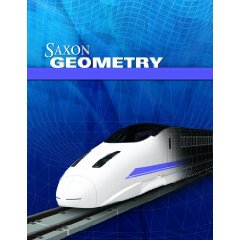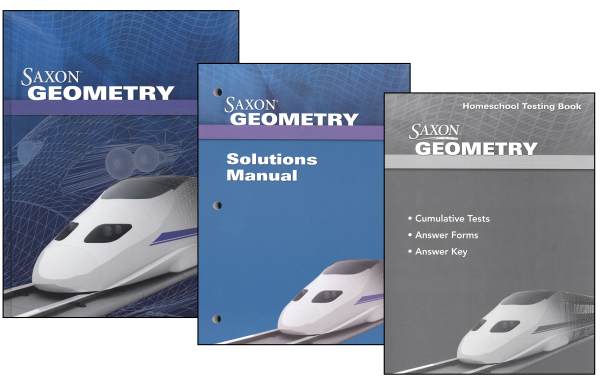High school geometry has sometimes been an issue for students using the Saxon texts since Saxon teaches geometry within Algebra 1, Algebra 2, and Advanced Math rather than in a separate course. In some situations, students have needed or preferred to take a separate year-long geometry course, which meant jumping to another publisher.
With Saxon Geometry, students now have more options. The publisher recommends using it after Algebra 2 third edition since a significant amount of geometry is taught at the end of that text. It makes a natural point at which students can switch over to the full-year course, possibly skipping geometry lessons in Algebra 2.
Students taking Algebra 1 in ninth grade might want to use Saxon Geometry in tenth grade in preparation for the PSAT test in their junior year or possibly for other test situations. This, too, will work, but not quite as easily as after Algebra 2.
All of this sounds a bit awkward, and it is. So Saxon has now come out with editions of the Algebra 1 and Algebra 2 designed to work specifically with Saxon Geometry. Titles are the same but the covers differ, so watch carefully to make sure you get the correct editions. These are the fourth editions, so that should be the easiest way to properly identify them.
As with the other Saxon texts, Saxon Geometry is written to the student so it is possible for them to work independently. However, it can also be used in traditional classrooms. Ancillary items, including a teacher's edition are available for those who might want to use the text with a class. (These items are not essential!) The text sometimes refers to "working with a partner," although those situations are easily adapted. The text is missing a few points of explanation: asterisks next to some questions indicate problems that should be done in a "classroom setting" with the parent/teacher nearby while other problems can be assigned for independent homework. Obviously, this makes little difference for most homeschoolers. Also, "Geometry Sketching Software" is referenced in a number of the lab activities with instructions for its use, but it is not part of the homeschool kit. This is The Geometer's Sketchpad from McGraw Hill Education. Homeschoolers can purchase it if they wish, but it is a bit pricey. The publisher tells me that it is not essential—students can skip those lab activities. However, students who will go on to higher math, especially computer-based math activities, would benefit from the use of the software.
Also, there is one "lab" activity that uses a graphing calculator. It walks students through step-by-step from the very beginning for this particular assignment having to do with scatterplots, but it does not really teach broader use of the calculator. Again, you could skip this lesson, but for students continuing on to higher math courses, it might be a useful time to introduce the use of a graphing calculator.
One feature that assists students working independently is the inclusion of sidebars with helpful instructional tips.
There are plenty of word problems and practical applications throughout the text, and many problems incorporate algebra to help keep those skills current.
Incremental instruction and continual review are also inherent to the Saxon Geometry text. Italicized numbers next to problems indicate the original lesson where the concept was originally taught, so students can easily review. Some concepts are reviewed in the Skills Bank at the back of the book and have "SB" in front of the number. (Note: I couldn't find any explanation of the "SB" to the student so this might need to be pointed out to them.)
The content coverage is similar to other geometry courses, although it has a bit more trigonometry than some. Proofs are taught very early and used throughout the course. Constructions with a straight edge and a compass are taught as labs within the pertinent lessons. Other labs have students do such things as make and use a hypsometer, cut and trace triangles to investigate symmetry and patterns, create and use a spinner to conduct a probability experiment, and use the Geometry Sketching Software.
Saxon Geometry is a challenging course. It really draws on higher-level thinking skills more than some other courses... another reason why it might better suit students who have already completed Algebra 2.
The Solutions Manual provides complete solutions to all textbook problems. The Homeschool Testing Book has tests for every five lessons beginning after lesson 10. The same booklet includes answers along with some detailed explanations, but it does not have complete solutions. The Testing Booklet has three reproducible solution/answer forms that you might have a student use to show both their work and their answers for the tests. The Solutions Manual and Homeschool Testing Book are included with the text in the homeschool kit.
Although Saxon Geometry lacks John Saxon's humorous touch, it does provide much more solid geometry instruction than is found in the other Saxon texts. In addition, the extensive work with proofs, challenging applications, and skill development suit the needs of students. While the original Saxon series retains all the geometry and does not require the use of this text, it is great to have this option.










